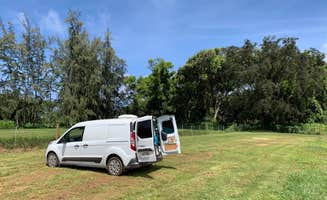Oahu's windward and leeward sides offer distinct camping experiences near Waimalu. Seasonal wind patterns affect shoreline camping conditions, with the windward side experiencing more persistent trades. RV sites near Waimalu, Hawaii are limited to designated parks within 20-30 miles, as most areas don't permit dispersed camping due to local regulations and protected land status.
What to do
Water recreation access: At Sand Island State Recreation Area, campers find surf breaks when conditions align. "The water is great for some body surfing," notes Leah P., highlighting opportunities beyond basic beachfront camping.
Hiking opportunities: The area surrounding Mālaekahana State Recreation Area offers trails for day hikes. "Lots of fun things to do and see nearby," mentions Laura H., referencing the recreation possibilities extending beyond the campground.
Horseback riding: Equestrian activities are available near several camping areas. "You can ride horses across the highway," states Steve & Ashley G. about Mālaekahana, adding another dimension to camping experiences beyond water activities.
What campers like
Protected camping areas: Security features appeal to many visitors. Laura H. appreciates that at Mālaekahana "the campsites themselves are blocked off by a gate with a keypad entry so there aren't random cars driving by your campsite ever."
Natural shade coverage: Bellows Field Beach Park offers ample tree cover for comfort. Noah L. comments, "Good trees for shade so you don't get too hot," while another camper notes the area "has plenty of trees to set up a slack line and hammock to relax and play."
Beach quality variations: Sand texture and conditions vary between locations. At Papohaku Beach Campground, Miles G. found "incredible views with miles and miles of beautiful beach," noting the remarkable solitude with "literally only saw 2 other people while I was there."
What you should know
Gate closure limitations: Several campgrounds restrict after-hours access. Crystal C. warns about Mālaekahana, "Gates close at 7:00 pm," which affects late arrivals and early departures.
Wildlife awareness: Natural hazards exist at some sites. "Watch out for centipedes; I got bit and it was extremely painful," cautions Crystal C. about her stay at Mālaekahana.
Site selection strategy: At Maleka Farm, positioning matters for comfort. Jake C. notes it's "a great spot for those needing a place to rest while exploring the area," suggesting its value as a base camp rather than a destination itself.
Beach conditions vary by season: Marine wildlife can affect swimming. Sandy S. warns about Bellows Field: "Beware the manawar here when it's in season. They line up all along the beach."
Tips for camping with families
Camp store convenience: Park Pick & Play @ Living Circle Farms Hawaii offers basic amenities for families who forget supplies. Mālaekahana campers appreciate that "the camp store is convenient for ice or marshmallows or any small needs."
Kid-friendly beaches: Gentler swimming areas suit younger children. Sarah I. notes about Sand Island, "The beach isn't the nicest but it's good for little kids and there's a nice surf break if the swell is in."
Weekday camping recommended: For quieter family experiences, timing matters. Sandy S. observes that Sand Island "is one of the least visited since the area is no longer a busy as it used to be," making it potentially better for families seeking calm environments.
Tips from RVers
Sand challenges: Beach proximity creates specific RV issues. Laura H. notes at Mālaekahana that "because it's the windward side, it was sooo windy and we really appreciated our campsite set a little farther back from the beach and protected by trees."
Site layout considerations: Haleiwa Camper Parking provides dedicated RV spaces, though without traditional amenities. At other locations like Bellows Field, campers report "the individual sites aren't really marked," requiring early arrival for optimal positioning.
Utility hookups vary: RV sites have inconsistent services across locations. While Sand Island offers electric hookups and a sanitary dump station, many other locations provide only partial hookups or none at all, requiring self-containment for longer stays.


